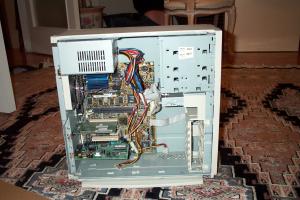
The box after cleaning, and before I started to fool with it.
One day I was walking down a busy street and saw lying on the sidewalk a discarded computer. I gave it a friendly kick and continued on my way, as I was off to have some coffee. When done coffee, I was surprised to see the computer still lying on its side. As one of my common expressions about computer equipment is: "Item X is so cheap nowadays I found it lying in a gutter and didn't pick it up!", I was curious exactly what is so cheap it would lie in a gutter unused.
My wife, who was with me, was unamused, no doubt foreseeing said computer lying on the doorstep of our house for a long time. "Nonesense! It still has a 3.5 inch floppy drive, and we know your drive is broken. That alone makes it worthwhile to carry home!" However, as I walked I started to dream of what more could come of this machine...
The machine is a sturdily built Dell MMX 166. It came installed with a working 3.5 inch floppy drive, case fan, some form of removable CPU cache, a S3 Virge video card, and what I think is a combination modem/soundcard, and a 230 watt power supply. It had obviously been already scavanged, as the main access panel had been removed. It had been lying beside it on the road, but I had left that piece as it was heavy enough to carry home. Interestingly enough, despite the fact it takes PC100 ram, the previous owner had scavanged that. Apparently RAM is not yet cheap enough to be found lying in a gutter! Quite surprising as this motherboard seems to only recognize up to 32 mb per slot...

The box after cleaning, and before I started to fool with it.
As alluded to earlier, as I realized this was a fully functioning machine, my goals went beyond mere salvage to the opportunity to indulge in a case mod. One case mod I had always wanted to try involved growing a live plant inside a running computer. With a free machine granted by fate, I could think of no better time...
Not wanting to invest lots of money into a free computer, I aimed my supply choices towards simplicity and cost. Pictured below are:
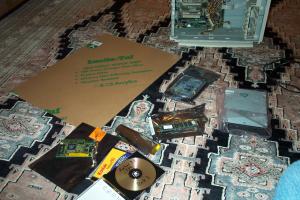
Most of the stuff to build your own plant comp!
As I wanted the computer to take the pictures, I needed some form of WebCam. As it happened an ex-Sultana member had a HomeConnect web cam, which was still at Sultana unused. I bit of research showed that there existed Linux drivers for this.
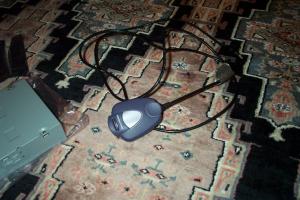
The HomeConnect Web Cam
The first phase of building was to get the old system ripped apart, and put back together with the new hardware. In this respect, the Dell case was both impressive and annoying. Impressive at the amount of metal and plastic you can remove from it. Annoying because you have to remove most of it to get access to anything.
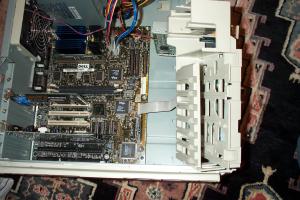
The front panel must be removed to remove the drive bay to remove
the bottom plastic insert to get at the floppy drive...
From there, it was a simple matter of plugging in the new cards and drives. I then cut the lexan to the right dimmensions and found some clips that could be used to hold it in place.

The machine ready for installation. Note the ancient serial dexxa
mouse. Also note the planter. The food is for me to eat while
installing.
Now all I had to do was install Redhat 7.2, the USB drivers, and then I'd be off! Right? Well... First I foolishly choose "Workstation" installation option, which intelligently doesn't install a telnet server or ftp server. What use is a workstation you can't telnet to? Who actually works on their own machine?
Then, I ran into what some no doubt predicted back when they saw the picture of the HomeConnect camera. I had a HomeConnect Lite, not the HomeConnect camera. As mentioned repeatedly on the various relevant web sites, the Lite camera is not supported by the HomeConnect drivers as it is entirely different hardware. I did go so far as grabbing USB Snoopy and trying to rev-engineer my own drivers.
Fortunately, I did notice that there WERE logitech quick cam drivers, and as it happened many local places had crates of such cameras for cheap prices. Thus, for slightly more than 128 mb of memory, I got a logitech quick camera:
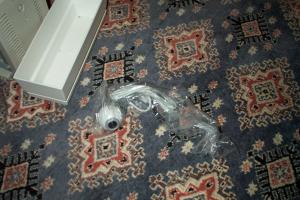
With the quick cam, the software proved a lot more tractable. The quick cam drivers worked as provided and I had xvtv showing the live camera output. Trying to get a frame grabber going proved more difficult. Here I had to take vgrabber and hack it to remove the auto-exposure code as most of my pics were in too low light situations. Then, replacing its back end with bmp output (I really had ppm!) and the creation of a few simple filters (median, average), I had an imaging set up going:
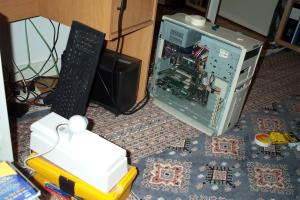
This was definitely the simplest part. While scarier, electricity does have the virtue of simplicity.
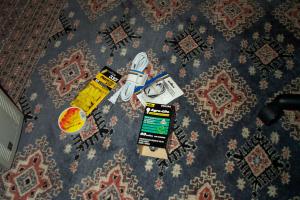
Components for a render farm: Electric tape, marrettes (note:
these are the wrong size for the pictured wire!), plug with built in
switch, light bulb base, and 60 watte grow bulb.
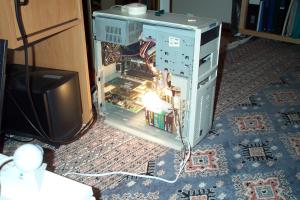
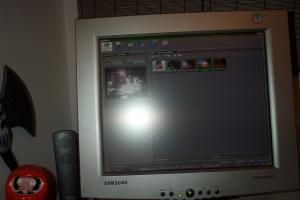
This formed my proof-of-concept. The wires are temporarily
electric-taped together, the final assembly uses the proper marrettes.
Pictures taken with this verified I could get reasonable output with
those light levels. The camera is hooked to my main computer as I
hadn't all the drivers working yet at this point.
I now moved to a undisclosed location to perform the actual installation. I have my brother to thank for providing much assistence with the technical work mentioned herein.
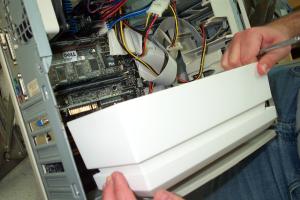
Here we see that the planter I got clearly won't fit without
modification. My original plan was to cut it to be half as long, but
that would risk breaking the water tightness. My brother suggested
rearranging the cards and reducing the height of the planter in the
card bay area.
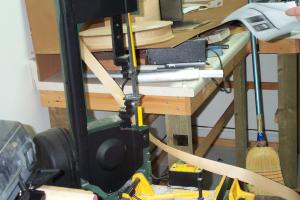
Perhaps there are more elegant ways to effect the change. Likely
not as much fun though.
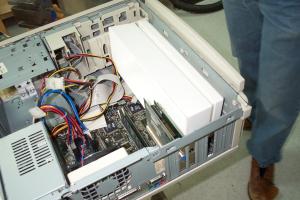
Hurrah! Fits like a glove!
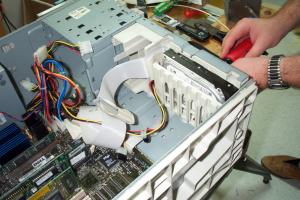
My brother pointed out the funny plastic bit at the front of the
case was the proper drive bay for the Dell machines. I was relieved
at this, as it would move the drive well away from both the plants and
the hot light.
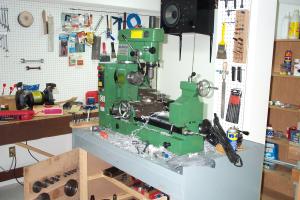
We didn't end up using the metal lathe. But I had to include it for
completeness.
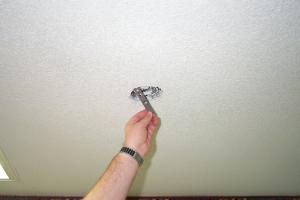
I was kicking myself for not having purchased a light bulb mount at Home
Depot. However, what other purpose do light fixtures have than to provide
miscellaneous hardware?
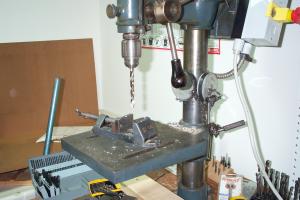
We did use the drill press to drill a hole in the drive bay panel
to screw the light into.

The mounted light. The drive bay formed the perfect location for
the light. The light was suspended a good distance from any thing
else, and what it was around was all metal.
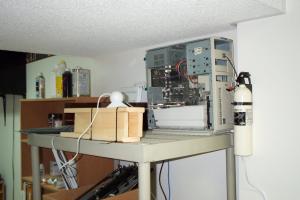
This shows it in its current configuration. We ran it with the
light on for a few hours to test for heating, but found that it kept
nice and cool. The big case fan easily handled both the light and the
CPU. The web cam is in the same position as we used for the pictures
shown on the previous page.
I still need to document this....
I still need to do this...